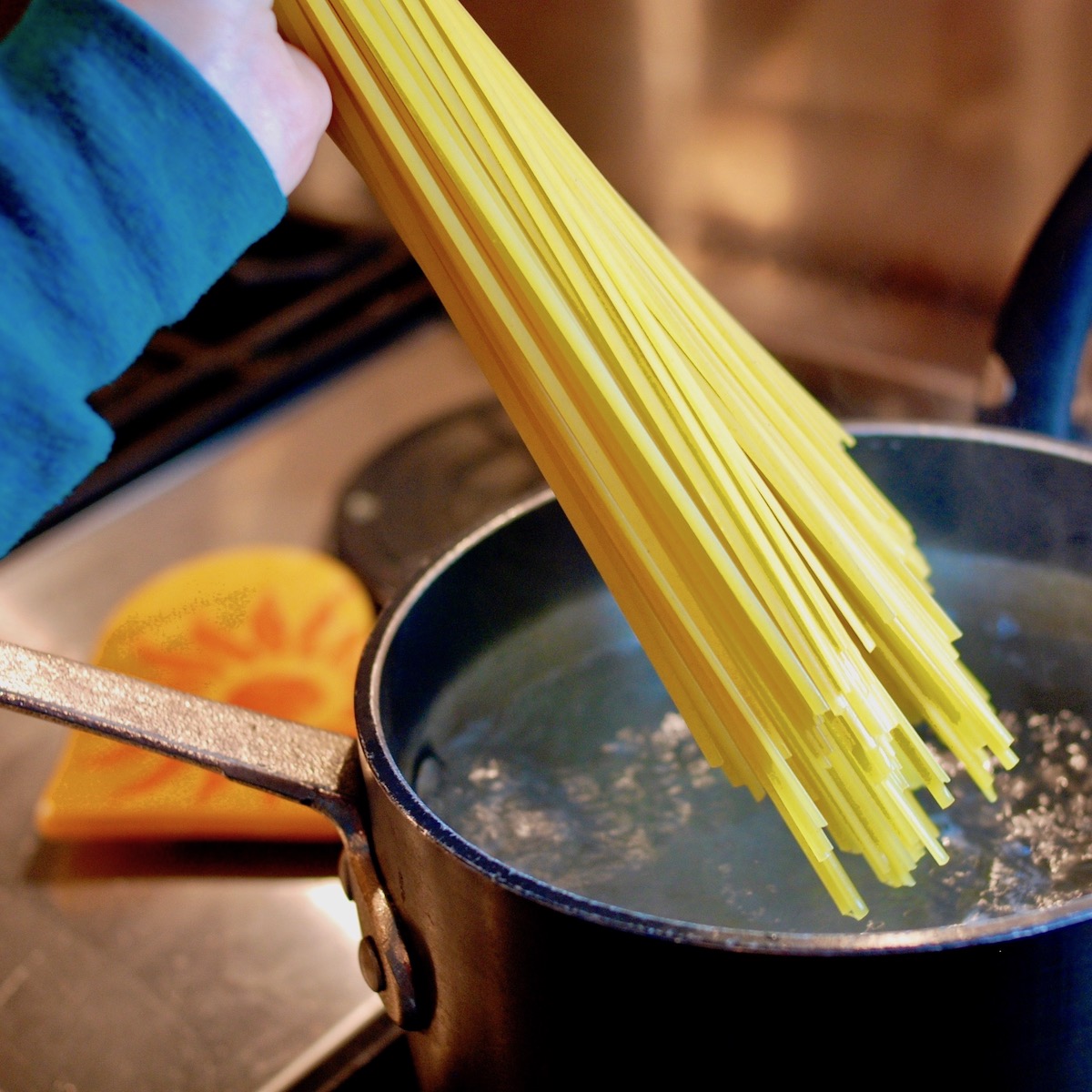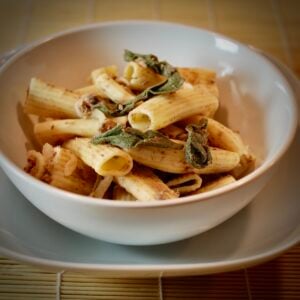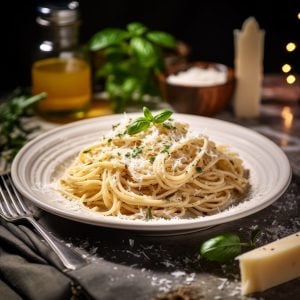How To Cook Pasta Plus Tips for Perfect Pasta
Thanks to the great American melting pot, pasta is a staple in the United States. So let’s look at how not to Cook pasta.
When “spaghetti and meatballs” turns up on children’s menus, you know what was once brought over by Italian immigrants is now as American as apple pie. I’d be willing to bet that most of you reading this have at least a box or two of dried pasta in the pantry, if not some fresh pasta in the refrigerator.
Americans eat roughly 20 pounds per capita of pasta annually. While that seems a lot, the folks in these countries have us beat: Switzerland, Greece, Tunisia, Venezuela and Italy. Italians, no surprise, consume the most pasta annually at just over 57 pounds per capita!
Pasta has been a staple in Italy for hundreds if not thousands of years. The most widely accepted theory of who “invented” pasta is that Arabs brought it with them during their invasions of the Italian peninsula in the 8th century AD. The making of both dried and fresh pastas proliferated from there, and dried pastas were especially prized for their keeping ability and nutritional content.
Contrary to what fans of low-carb diets would have you believe, pasta is not a “bad food.” The carbohydrates in pasta are broken down slowly over time and don’t cause extreme spikes in blood sugar. Indeed, most semolina-based pasta products are rated as having a low glycemic index.
Furthermore, pasta is relatively low in calories and fat but high in protein, complex carbohydrates for energy, fiber and B vitamins. All that without sauce! Add some flavorful, low-fat sauce containing a wide variety of fresh vegetables, and you’ve got a seriously nutritious dish.
While fresh and dried pasta are certainly related, they are not identical. Most dried pastas are made from 100% semolina flour. Semolina is ground from durum wheat, a hard wheat with a high protein content. Enough water is mixed with the flour to create a strong dough which is then kneaded and rolled and finally cut or extruded into specific shapes.
If you look at the ingredient list on a box of dried pasta, you will see that water is not even listed as an ingredient. The water is only there to form the dough before shaping and drying.
Fresh pasta is made from dough that often contains eggs, salt and a bit of fat as well as flour. Fresh pasta is generally more delicate than dried and also cooks much more quickly.
While the cooking of pasta seems fairly straightforward, there are some pitfalls to watch out for.
Mistake #1 Crowding the Pot
Sometimes it can be a pain to lug out your huge pot to boil up some pasta, so you just use a small saucepan, break the noodles up and set it to boil. You come back a few minutes later to find your pasta all gummy and stuck together.
The Fix—Use a Lot of Water
Since pasta is made of wheat flour, it contains a lot of starch. Starch is produced by all plants and is basically the way they store food. Humans have pantries. Plants have starch.
Starch does not dissolve in cold water, but once water gets hot and comes to a boil, the starch granules swell up and gelatinize. This is what makes puddings thicken.
If you are not using plenty of water to cook your pasta, you will end up making pasta pudding. The starches will swell up and stick together, and you’ll have pasta that is all stuck together.
To keep this from happening, use at least a gallon of water per pound of pasta. Don’t add the pasta until the water is at a full boil, and stir to keep the pasta from initially sticking together until the water returns to a boil and the agitation from the bubbles keeps the pasta moving.
Mistake #2 Slimy Noodles That Sauce Won’t Stick To
So, now you’re using enough water and stirring your pasta. There should be no reason to add oil to the pot. Still, people persist in adding oil to pasta water in the hopes that the oil will keep the pasta from sticking together.
This isn’t true, most of the oil floats on top of the pot and gets poured down the drain. Any oil that clings to the pasta will just make it slimy and keep any sauce you are using from sticking to the noodles.
The Fix—Back Away from the Oil Can
Make sure to use plenty of water. Make sure the water comes to a rolling boil before adding the pasta. Stir until the water comes back to a rolling boil. If you follow these rules, your pasta will come out fine, so don’t waste your oil.
Mistake #3 Bland Pasta
Dried pasta doesn’t contain any salt, so by itself, it will taste very bland. Don’t think that you can save bland pasta by serving it with an overly-salted sauce. You’ll just end up with salty sauce on bland pasta.
The Fix—Salt the Water
Think of pasta cooking as the noodles absorbing boiling liquid until it is soft and flexible. It stands to reason that the pasta will take on the flavor of water liquid is absorbed.
To adequately season your pasta, cook it in well salted water. The water should taste like the ocean.
You will need about 1 tablespoon per gallon. While this might seem like a lot of salt, keep in mind that only a small amount will be absorbed and the rest will go down the drain.
For additional flavor, you can even consider cooking your pasta in boiling chicken or vegetable broth instead of salted water.
Mistake #4 Mushy Pasta
Pasta left to cook too long will continue to absorb water and then swell up as all the starches in the noodles fully gelatinize. Not only will their texture be mushy, they will also easily break up when stirring or attempting to serve them, and they won’t be as nutritionally viable.
For one thing, with all the starches gelatinized, the complex carbohydrate structure of the pasta will be compromised and its glycemic index will rise since the body will break it down more quickly. Suffice to say that overcooked pasta is unappetizing.
The Fix—Set a Timer
Most boxed pastas come with a suggested cooking time. Start checking your pasta a good three or four minutes before the low end of the range given. For example, if the box says 10-12 minutes, start checking it in 6-7 minutes. What you’re looking for is a texture called “al dente.”
Al dente is an Italian term that literally translates to “to the tooth.” This means that the pasta should offer some resistance when you bite into it.
What you should see when you break apart of al dente spaghetti, for example, is cooked pasta surrounding a small dot of uncooked pasta. When you bite into al dente pasta, you shouldn’t hear a crunch, but there should be definite resistance as you bite through the middle.
Many people think that you can tell whether pasta is done by throwing it against a wall. All this really does is make a mess. Besides, your wall won’t be eating the pasta, you will. Do yourself, and your walls, a favor and taste for doneness instead.
Mistake #5 Rinsing off the Starch
Even if you use gallons and gallons of water to cook your pasta, there will still be starch coating the pasta strands. So, you end up rinsing your pasta. Then, when you serve it, you end up with a pool of sauce under the pasta.
The Fix—Don’t Rinse
Yes, you will still have starch on your pasta after draining. This is just the nature of pasta—it is wheat-based, and wheat contains a starch. While you will pour a goodly amount off in the cooking water, a little starch is a very good thing.
Since starch is sticky, your sauce will stick to the pasta better if you don’t rinse it. The only exception to this is if you are making a cold pasta dish, such as a pasta salad. You can rinse the pasta with cold water to keep it from overcooking.
Even so, I would advise undercooking the pasta by just a hair, and adding the sauce ingredients to the pasta while it is still hot so that the pasta will absorb the sauce. Then, once the pasta is cool, add the rest of your ingredients, such as vegetables, meats and cheeses.
Mistake #6 Pouring Out All the Pasta Water
As I’ve stated before, pasta cooking water ends up containing a lot of starch and some salt, most of which you will pour down the drain. Since starch is such a good binder and salt is an essential seasoning, it does make sense to hold back some of the pasta water to use when you eventually marry pasta to sauce.
The Fix—Save Some of the Cooking Water
When your pasta has reached al dente, dip out about a cupful of cooking water before draining your pasta. Depending on how much pasta you have cooked, you might not need all of it, but it’s better to have too much than not enough.
For the procedure for using some pasta water to help finish your sauce, see the discussion under Mistake #7.
Mistake #7 Pouring the Sauce on the Pasta
On first glance, this doesn’t seem like a mistake. How many times have we cooked pasta and then poured the sauce on top of individual servings? Probably more times than we can count.
If you do this, though, what you’re serving is pasta and sauce, not a wonderful dish made when the two elements are brought together correctly.
The Fix—Finish Your Pasta Correctly
Once you have reserved a cup of pasta water, have drained your pasta and have the sauce ready, here is a great way to marry the pasta with the sauce. I am not telling you that this is the only way, but it is tried and true, and it is the method that I use.
- Put the drained pasta back in cooking pot.
- Ladle in about ½-3/4 cup of sauce per serving.
- Add about half of the reserved cooking water to the pot.
- Over high heat, stir gently but constantly as the sauce boils and the starchy water reduces so that the sauce regains its original consistency. This should only take about one minute.
- Add a touch of fat to the pan—heavy cream, butter or olive oil would be appropriate—and continue stirring until the fat is well incorporated.
- Turn off the heat and stir in a bit of hard cheese, such as Parmesan or Romano.
Why this works:
The starch on the noodles along with the starch in the cooking water help to thicken the sauce and make it adhere to the pasta. The stirring action coupled with boiling help to emulsify the fat, lending a creaminess and silky mouthfeel to your sauce.
The cheese adds a nutty note, a little salt, and a bit of depth to the sauce. The result is that each noodle bears a thin, creamy coating of sauce.
Mistake #8 Making Too Much Pasta
I understand how it can be, living in a busy household. The temptation is there to just cook a ton of pasta and eat the leftovers over the next couple of days. When you reheat your meal the next day, though, it just doesn’t seem to taste as good as it did the first day.
The Fix—Only Make As Much As You Can Eat
Leftover pasta doesn’t taste as good as freshly cooked pasta because, in the act of reheating, you are overcooking your noodles. And we’ve already talked about how unappetizing overcooked noodles are.
Mistake #9 Not Matching the Right Sauce to the Right Shape
With over 350 noodle shapes ranging in size from large lasagna noodles and manicotti to tiny stars for soup, it can be a little overwhelming trying to decide what sauce to pair with what pasta shape.
If you use a light sauce on large noodles, you’ll end up only tasting noodles. If you use a heavy sauce on small or light pasta, you’ll end up with a large pool of chunky sauce after you’ve eaten the last noodle.
The Fix—The Perfect Pairing
For pairing pasta shapes with sauces, the general rule of thumb is pair lighter, delicate sauces with smaller or finer pasta shapes. Pair hearty or chunky sauces with hearty pasta shapes.
Ribbon-type pastas, such as fettuccine, tagliatelle and papardelle pair nicely with cream sauces, hence the ubiquitous Fettuccine Alfredo. There is plenty of surface area for these silky sauces to cling to.
Light marinara and light seafood sauces pair well with long, tube-shaped pasta like capellini (angel hair), spaghetti and even linguine. Pair chunkier, heartier sauces such as primavera and Bolognese with hearty, short pasta shapes, such as rigatoni, penne, ziti.
For very small pasta shapes, such as stars and alphabets, it is best to serve them as part of a soup in a light broth.
Mistake #10 Over Saucing
Properly cooked and seasoned pasta is a treat, both in flavor and in texture. In Italy, pasta is served as one course of a larger, multi-course meal, so it is lightly sauced so that the flavor of the pasta is prominent.
Here in America, where we generally only eat one course at home, the pasta just seems to be the vehicle to get the sauce to our mouths. This is not necessarily a bad thing, especially if you are serving a healthy sauce. If you generally bury your pasta under a mound of sauce, do yourself a favor and sauce lightly.
The Fix—Use Just Enough
Mario Batali has said that the word Italians use to denote their pasta sauce means “condiment” in English. If you consider sauce as the condiment to the pasta, it becomes easier to understand the traditional relationship between pasta and sauce.
The sauce is there to enhance the flavor and texture of the pasta, not hide it. Just as you wouldn’t put so much ketchup or special sauce on a hamburger that you can’t pick it up without its dripping everywhere, you also should only use enough sauce to coat and enhance—rather than drown —each noodle.
Pasta can be a delicious part of a healthy diet. Avoid these pasta pitfalls and you will be a pasta pro in no time.
How NOT to Cook Topics |
||
| Introduction | Braise | Roast |
| Start a Recipe | Cook Pasta | Saute |
| Season Foods | Grill | Simmer |
| Bake | Pan Roast | Simmer |
| Boil | Poach | Steam |








2 Responses
I agree with most of what you said, but lately I’ve been doing the trick of using less water and sometimes starting in a cold pot as mentioned on SeriousEats.com. You end up with a higher starch percentage in the water, which helps your sauce. The only downside is that you have to be attentive when the pasta is put in the pot, you can’t just throw it in and go do other stuff.
Tim, thanks for the tips. I will have to give them a try. I especially like your comment about being “attentive.” I think it is an issue many home cooks struggle with because there can be so much going on in one’s life. Cooking, setting the table, helping the kids, etc.